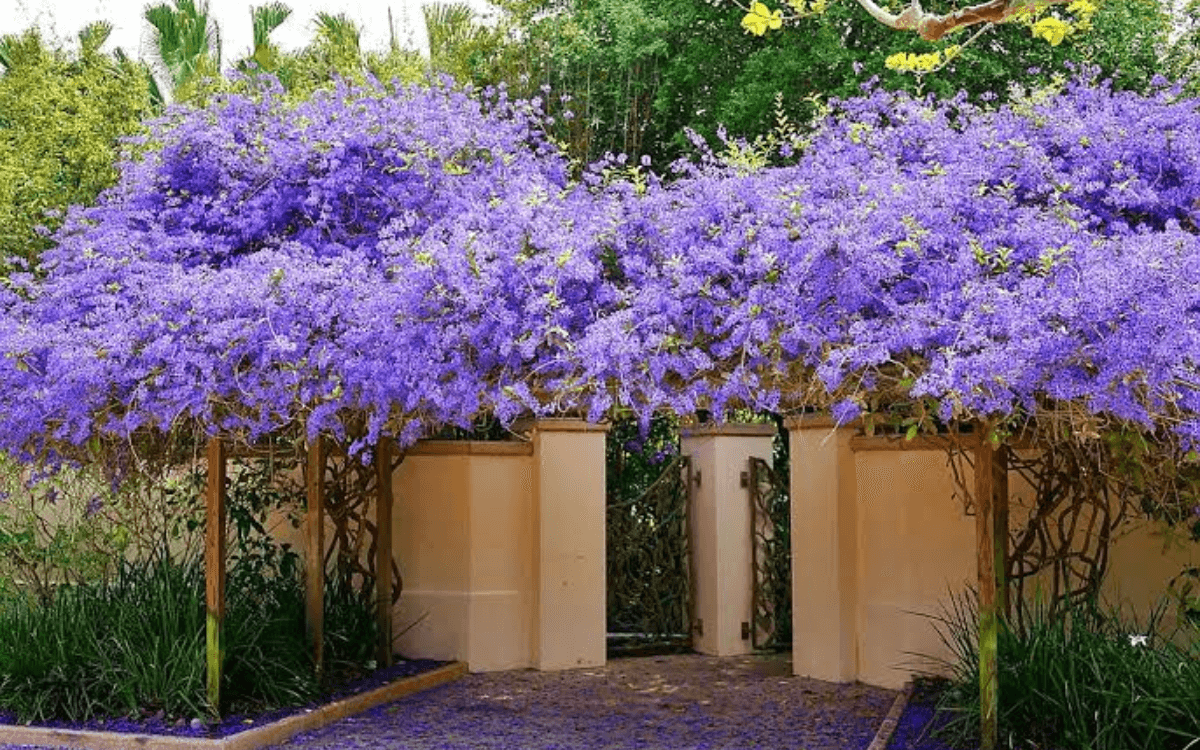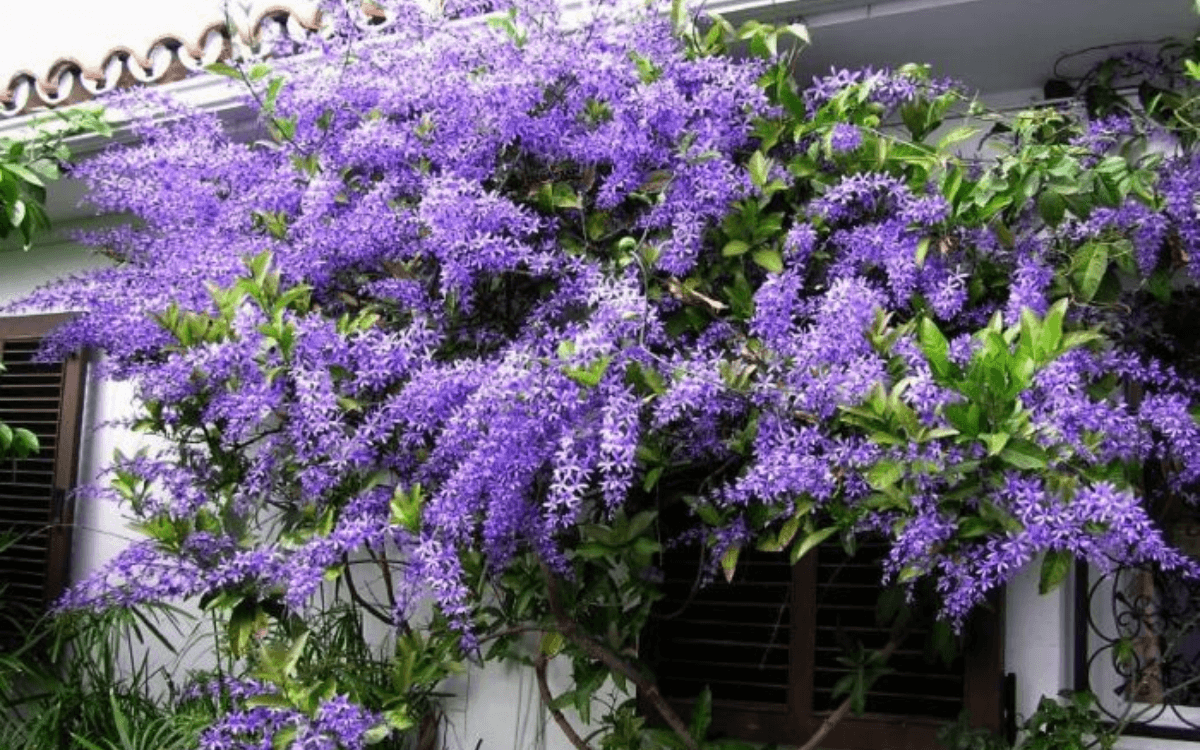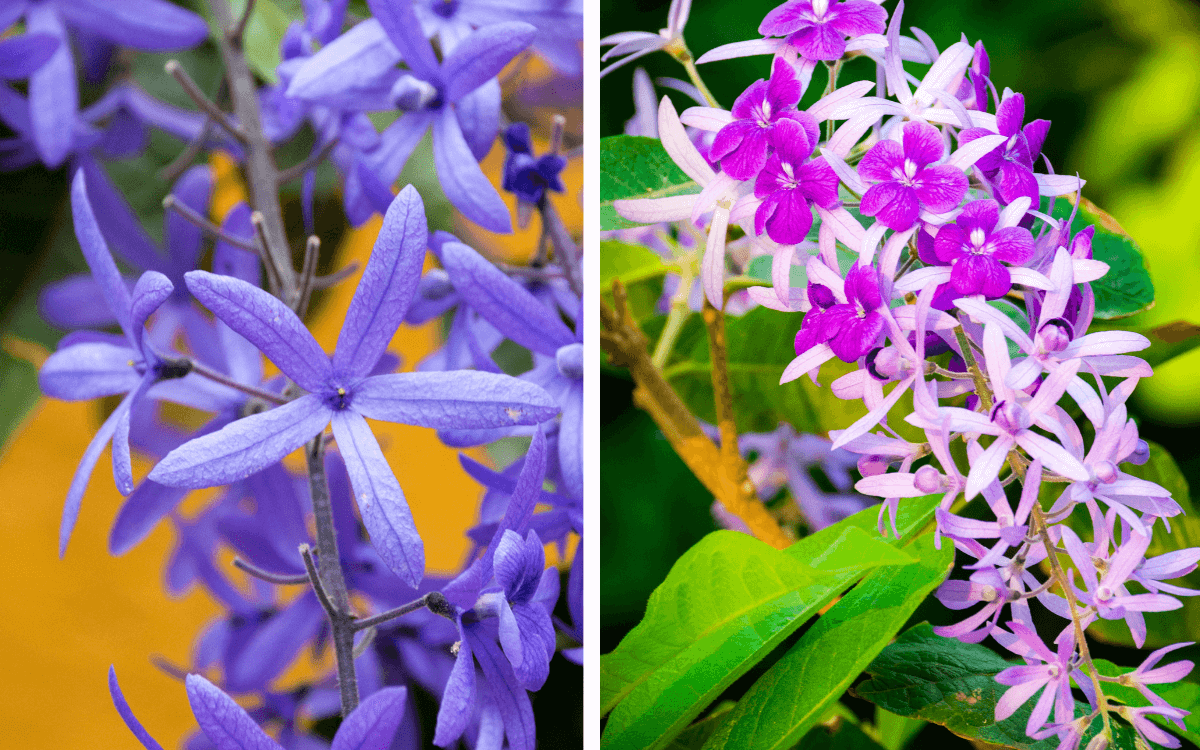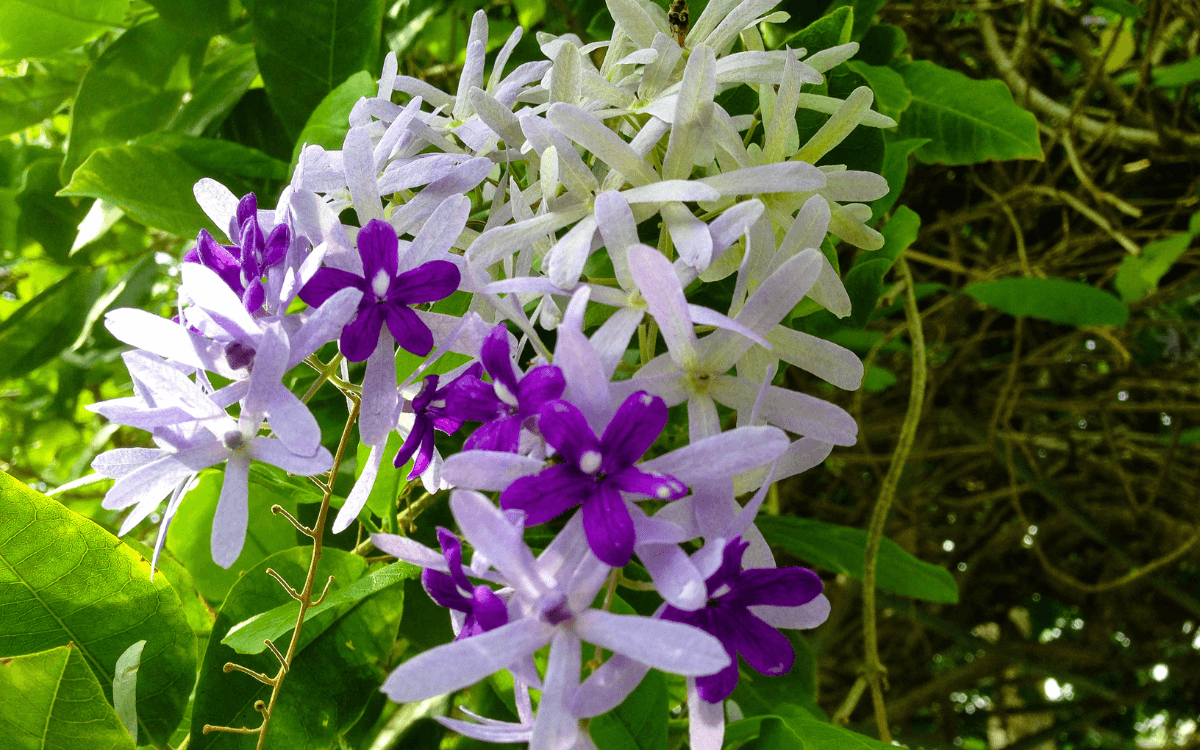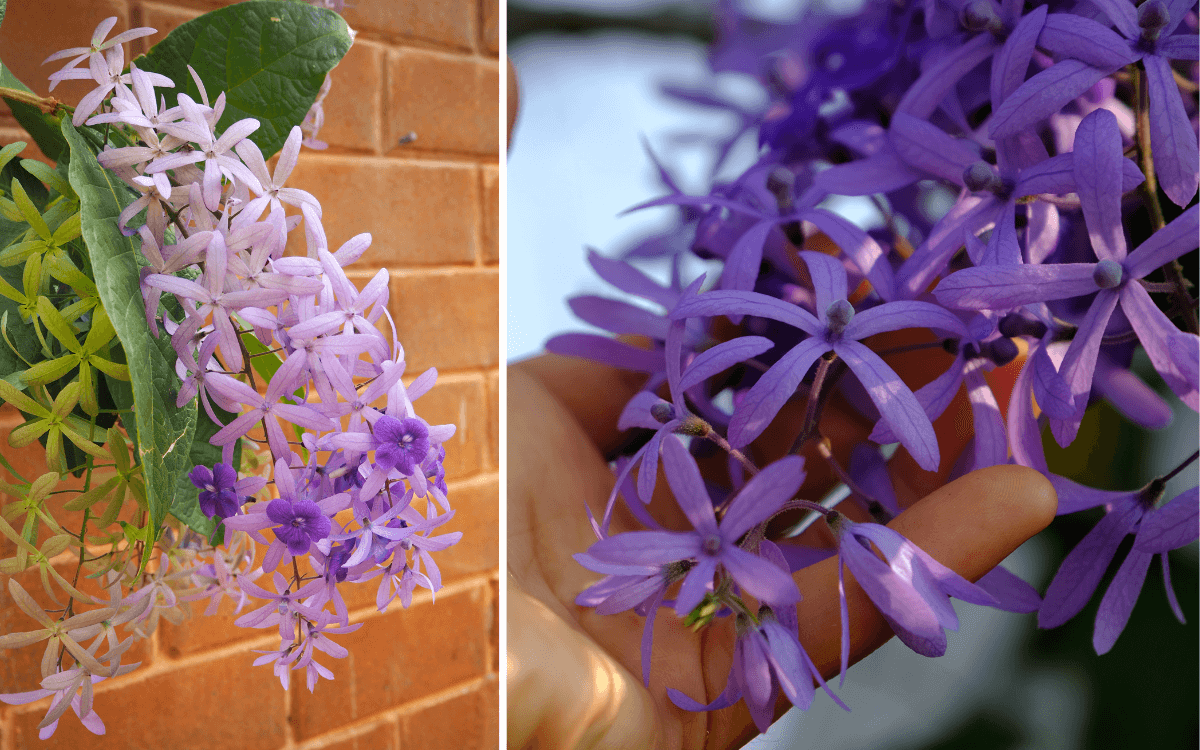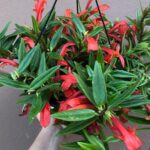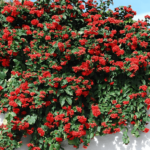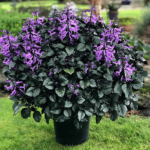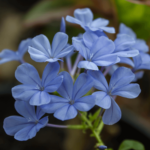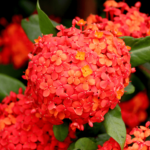The Sandpaper Vine (Petrea volubilis), also known as Queen’s Wreath, is an ornamental and flowering climber that can reach an impressive height of 12 meters (39 feet).
Its stems, robust and vigorous, are a hallmark of this plant, providing it with the strength necessary to grow and develop majestically.
The leaves of the Sandpaper Vine are notably wide and pointed at their ends, giving it a unique and intriguing appearance.
One of the most captivating features of this plant is its flowers, which can come in two main variations:
- They display thin and long petals.
- They have four central round and small petals.
The flowers group together in generous clusters, more than 30 cm (about 12 inches) in length, creating a visual spectacle that attracts admirers and pollinators.
Its geographical distribution is notable, adapting to temperate and tropical climates, it demonstrates a resistance to light frosts, although its true splendor is revealed under full sunlight, which stimulates an exuberant flowering.
In addition to its stunning beauty, the Sandpaper Vine is also known for its spiritual and cultural properties.
It is considered capable of neutralizing negative energies and undoing works or spells, being valued in different traditions.
Below you will learn in more detail how to cultivate this plant.
Ideal Climate
The Sandpaper Vine is a plant that appreciates direct sunlight, and it is essential that it be cultivated in locations that receive a generous amount of sunlight.
Ideally, the plant should enjoy at least 6 hours of sunlight per day.
This adequate sun exposure is crucial for stimulating an exuberant flowering and keeping the leaves healthy and vibrant.
Therefore, when planning the planting location, make sure to choose a site that provides this necessary sun exposure.
Regarding temperature, the Sandpaper Vine prefers warmer climates.
Therefore, when cultivating it in colder regions, consider measures to protect it during periods of intense cold to avoid development issues.
Well-ventilated locations that allow good air circulation are highly recommended.
Ventilation not only contributes to the health of the plant, assisting in the prevention of diseases and pests, but also positively influences its flowering.
Soil
To ensure the Sandpaper Vine flourishes and thrives, it is crucial to choose soil that is well-drained.
This means that the soil must allow efficient water passage, avoiding excessive moisture accumulation around the roots. Additionally, the soil should be deep enough to accommodate the robust growth of this climber and its vigorous roots.
The richness in nutrients is another critical factor for successful cultivation of the Sandpaper Vine. The soil must be enriched with essential nutrients to support the plant’s healthy growth.
An excellent way to achieve this is through the addition of organic compost to the soil.
Organic compost not only improves soil fertility but also helps retain moisture, creating a conducive environment for root development.
How to Water the Sandpaper Vine
Keeping the soil slightly moist is key to successful watering of the Sandpaper Vine. It is essential to water the plant whenever the top layer of soil begins to dry out.
This ensures that the plant’s roots have access to the necessary moisture for healthy development.
However, it is crucial to avoid waterlogging the soil, as excessive water accumulation can harm the plant and its roots.
During the warmer periods, when the Sandpaper Vine’s water demand is higher, it is advisable to increase the frequency of watering.
About twice a week may be the ideal frequency to keep the soil adequately moist during these times. Observing the climatic conditions and the state of the soil is important to adjust watering as needed.
Additionally, it is important to note that locations with high air humidity, especially on sunny and intense days, can contribute to excessive soil moisture.
Therefore, it is necessary to carefully monitor the soil’s moisture and avoid over-watering when climatic conditions favor moisture retention in the soil.
Fertilization
For fertilization, it is highly recommended to use fertilizers enriched with potassium and phosphorus, especially during the plant’s flowering stage.
These nutrients play a crucial role in the development of flowers and in promoting a lush and long-lasting flowering.
Additionally, formulations like NPK 10-10-10 can be a suitable choice to meet this plant’s nutritional needs.
It is important to fertilize moderately and follow the instructions of the chosen fertilization product, as excessive fertilization can be harmful to the plant, therefore, it is essential not to overdo the amount of fertilizer applied.
If the Sandpaper Vine shows signs of nutritional deficiency or if growth and flowering are not occurring as expected, additional fertilization may be necessary to meet its needs.
Planting, Replanting, and Propagation
During planting or replanting, a recommended practice is to remove the lower leaves of the plant. This helps reduce water loss and directs the plant’s energy towards proper growth and development.
When it comes to propagating the Sandpaper Vine by cuttings or seeds, selecting a healthy mother plant is crucial.
It is important to use sterilized tools to avoid diseases during the cutting process. Cuts should be made on healthy lateral shoots, allowing the growth of new seedlings.
Pests, Diseases, and Other Problems
In this section, you will learn about the 3 most common threats to the health of the Sandpaper Vine and specific solutions for dealing with each of them.
Mites: These small insects can be a threat to the Sandpaper Vine, as they feed on the sap of the leaves, causing yellow spots and weakening the plant. To combat mites, it is recommended to use specific insecticides designed for this pest or even insecticidal soap, which can be less harmful to the environment.
Fungi: Excessive moisture conditions can favor the emergence of fungi, which can cause spots on the plant’s leaves. To prevent the appearance of fungi, it is advisable to apply fungicides according to the product’s instructions and control the amount of watering, avoiding excess moisture in the soil.
Scale insects: These sucking insects tend to lodge on the leaves and stems of the Sandpaper Vine. To solve the problem of scale insects, it is possible to remove them manually using a damp cloth or use mineral oil, which suffocates these pests.
Finally, regular observation of the plant plays a crucial role in the early detection of any sign of infestation or disease. By quickly identifying problems, you can apply the appropriate solutions in time to avoid significant damage to your Sandpaper Vine.
Other Tips
Special Features: the Sandpaper Vine is a climbing plant that originates from the tropical regions of Central America and the Antilles. Its purple flowers are highly ornamental and have the power to attract bees, butterflies, and hummingbirds, making it an attractive addition to your garden.
Application Versatility: this plant is often used to decorate walls, fences, railings, gardens, and balconies. Its resistant nature and easy maintenance make it a popular choice for those looking for a charming climbing plant.
Learn more: did you like this article? Then continue learning with us how to cultivate your plants. Below are some texts that may interest you:
- China Rose (Rosa chinensis): 8-Step Care Guide
- Ficus Lyrata (Fiddle-leaf fig): 7-Step Care Guide
- Ficus Benjamina (Weeping Fig): Plant Info and Care
- String of Pearls Plant – Step By Step Care Guide
- Fishbone Cactus (Selenicereus anthonyanus) – Care Guide
- Monkey Tail Cactus: How to Care and Propagate
Also leave your comment below in case you have any questions or stories with this plant that you would like to share.

